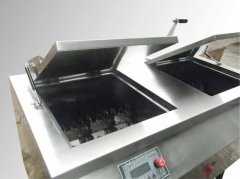Color fastness is the ability of fabrics to retain the dyes used to color them. Some fabrics hold dye within their fibers extremely well - like denim - while others do not (mostly synthetic or artificial non-natural fabrics) and tend to "bleed" when they are washed. The denim would therefore be more "color fast" than the other fabric.The resistance of a material to change in any of its color characteristics, when subjected to washing is called color fasntess to washing.
General Principle:
A specimen of the textile to be tested, with the adjacent fabric attached is subjected to washing under specifiend conditions. The extent of any change in color and that of the staining of the adjacent fabric are assessed and the rating is expressed in fastness numbers.

There are two types of adjacent fabrics; (1) single fibre fabric and multiple fibre fabric. In the case of multifiber fabric only one specimen is required and in the of single fiber fabric two adjacent faabric are required.
There are various colorfastness tests. Details of washing fastness tests are given below.
Fastness to Washing:
In the test, change in color of the textile and also staining of color on the adjacent fabric are assessed. A 10 x 4 cm swatch of the coloured fabric is taken and is sandwitched between two adjacent fabric and stitched, The sample and the adjacent fabric are washed together. FIve different types of washing are specified as different washing mthods.
|
Fastness to Wash
|
|
Sr.No
|
Method
|
Washing severity
|
Soap+Soda in grams/liter
|
Time in minutes
|
Temperature
|
Steel balls
|
|
1
|
IS:687:79
|
Very mild like hand wash
|
5
|
30
|
40+/- 2
|
Nil
|
|
2
|
IS:3361:79
|
5 times severe than method 1
|
5
|
45
|
50+/- 2
|
Nil
|
|
3
|
IS:764:79
|
Mild washing
|
5 + 2
|
30
|
60+/-2
|
Nil
|
|
4
|
IS:765:79
|
Severe washing
|
5 + 2
|
30
|
95+/-2
|
10
|
|
5
|
IS:3417:79
|
Severe washing
|
5 + 2
|
4 hrs
|
95+/-2
|
10
|
The solution for washing should be prepared to the required temperature of washing. The liquor material ratio is 50:1 . After soaping treatment, remove the speciment, rinse twice in cold water and then in running cold water under a tap. Squeeze it and air dry at a temperture not exceeding 60°C. The change in color and staining is evaluated with the help of grey scales.

